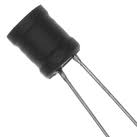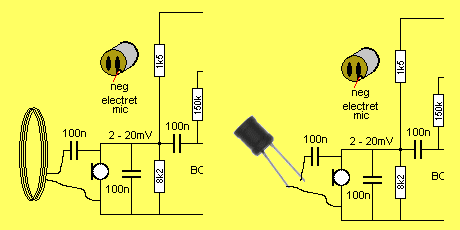|
INDUCTIVE |
Turn any Hearing Aid
into an Inductive Hearing Aid.
![]()
This
handy project turns almost any Hearing Aid into an Inductive Hearing Aid.
An Inductive Hearing Aid has a coil connected to the front-end of the
amplifier in place of a microphone.
This coil picks up electromagnetic radiation.
Electromagnetic radiation is similar to a radio transmission but at
a much-lower frequency.
It is generated by connecting a coil across the output of an amplifier.
The amplifier can be a radio, TV or Public
Address system, and if the wearer of a hearing aid has an inductive
coil connected to the aid, he will be able to hear
the output of the radio or TV etc.
This will be an enormous advantage to a deaf person as the level of volume
in a church or meeting place is quite low compared to someone talking
directly to them.
To those of us with normal hearing, we can adapt to the different
volume levels.
But an electronic circuit such as a hearing has to be adjusted.
The wearer has to turn up the gain of the
"aid" and this sometimes results in feedback. But the main problem
is the
aid is operating at its maximum gain and the result is a distorted sound.
Our project overcomes this problem.
An inductive loop is placed around the perimeter of a room, or placed
nearby, so the
setting of the aid
can be reduced.
This prevents the possibility of an annoying feedback whistle and the
clarity is increased.
Some churches, meeting places and theatres have an inductive loop
installed around the room to allow those with
inductive hearing aids to take advantage of the "pick-up."
This project can be used when this loop is available.
The need to turn up a hearing aid and listen to distorted audio
is very annoying.
Any one in your family who wears a hearing aid will like this project.
There are other uses for this project:
A loop can be placed around the neck of the wearer to create a "wireless
link." The loop is connected to the output of a radio or CB
radio and the wearer can listen without the need for wires.
An "in the canal" heading aid can be purchased (very expensive) to create
a link like this, for a security guard in a light-club, for example.
There are a number of very cheap hearing aids on the market through
mail-order companies or they can be purchased as spy ear from toy shops. These can be converted to an Inductive Hearing Aid
by adding the receiving coil described in this article.
Some hearing aids have an inductive pick-up already
inside the case but they are very expensive. The cheap versions do not have
this feature.
This is surprising as an inductive pick-up is simply a coil consisting
of many turns of fine wire. It's one way of "value adding" to a
product and profiting
from those who need a particular feature. That's why hearing aids were
notoriously expensive, until Chinese copies came on the market.
Although it is possible to build the amplifier for the hearing aid, some of
the parts are difficult to obtain (such as the earpiece) and the case is not available from any
source.
That's why we have suggested buying a ready-made unit and adapting it
to detect the signal from an "audio-loop."
MAKING THE RECEIVING COIL
To turn an ordinary
hearing aid into an inductive hearing aid, we add a coil of wire in
place of the microphone.
This coil of wire can be very small or as large as book.
A large coil will provide a longer range. It has no effect on the
clarity or the loudness.
We have suggested three different coils and you can choose the type you
want to use.
1. The receiving coil can be
a 10mH choke as shown in the photo:
In fact it can be any value of inductance but a 10mH choke will have the
largest number of turns and this will produce the best results.

2. The receiving coil can be 100 turns of
0.2mm wire wrapped around the hearing aid or around a matchbox. This
will give a better range than the 10mH choke.
3. But the longest range will be produced with a coil of 50 turns or
more wound on a book or tin with the largest diameter. Place a ruler or
pencil against the tin so that it can be removed and the coil taken off
when all of 50 metres of wire has been used.
Use sticky-tape to keep the turns in place. The coil can be any shape
but the best is a smooth round circle. The turns can be jumble-wound as
the winding makes no difference.
Scrape the enamel off the ends and the coil is ready.
Open up the hearing aid and
locate the microphone.
Solder one end of the coil (or the 10mH inductor) to either wire that
comes from the microphone. It is best to do this where the wire joins
the PC board so the microphone is not heated up.
Now get a 100n monoblock capacitor (see photo):

Solder one lead of the capacitor to the
other lead of the coil and solder the second capacitor lead to the other
microphone wire.
Here is the circuit:

Connecting the coil to a
hearing aid
Connecting the coil across the microphone
will reduce the sensitivity of some hearing aids and the volume will
have to be turned up more but the advantage of placing the coil across
the microphone means the listener can hear the audio from the room at
the same time as hearing the audio from the loop.
The microphone can be removed or a switch used to select between
microphone and inductor.
MAKING THE TRANSMITTING COIL
The other part of this
project is the transmitter or transmitting coil.
We need to have a 50 turn transmitting coil at least 30cm diameter to
create the electromagnetic radiation that will be picked up by the
inductive hearing aid.
This transmitting coil is connected to the output of a radio by simply
soldering the ends of the coil to a plug that fits into the "ext spkr"
of a radio. The coil will now take the place of a speaker and instead of
the energy of the radio being delivered to an external speaker, it get
delivered to our coil.
The transmitting coil can
be any diameter, any number of turns and any gauge of wire.
We have experimented with a number of designs and the best performance was
50 turns of 0.5mm enameled wire, 30cm diameter.
The coil can also be 10-20 turns of wire around the ceiling of a room.
This will give everyone in the room an equal opportunity to receive the
signal.
MODIFYING A
RADIO OR TV
Most radios and TV's have a "headphone" socket. When a set of headphones is
plugged into this socket, the main speaker is disconnected. To stop the
speaker turning off, the side of the plug is filed so that when the plug
is inserted, it does not activate the switch.
TRANSMITTING RANGE
The transmitting range for an audio loop is very short, when compared to
RF transmission.
Even though the energy is ELECTROMAGNETIC RADIATION, it is a very low
frequency and the signal contains very little energy.
In most cases the receiver (the hearing aid) must be situated within the loop or
a very short distance away.
The transmitting and receiving coils must be in the same plane to achieve
the greatest range.
To explain this more clearly we place the transmitting coil on the
work-bench and point the single-ended choke at the centre of the coil. The
flux rises from the centre of the coil and passes through the ferrite of
the inductor. This produces a waveform (a voltage) in the winding of the
inductor and the amplifier increases the voltage level to drive the
earpiece.
We achieved a listenable level up to a range of 80cm.
The range for a larger coil is much more. A 10cm to 30cm receiving coil
will operate from 1 metre to 5 metres, depending on the size of the
transmitting coil.
| |
|
28-7-2010